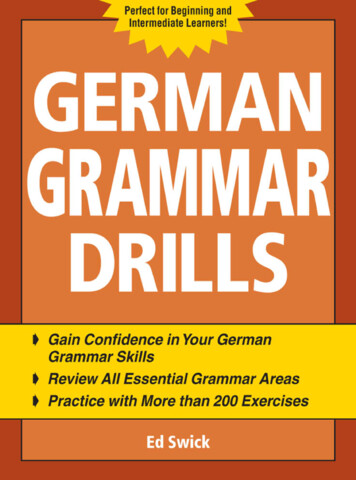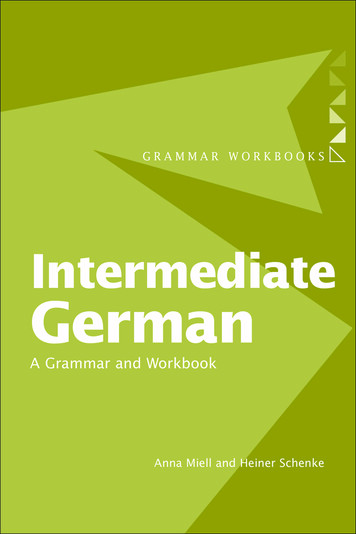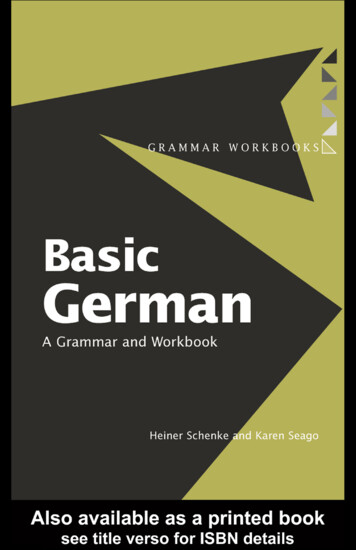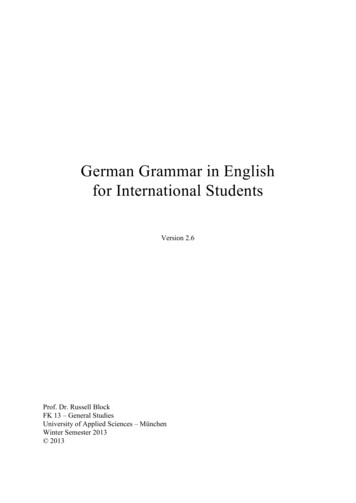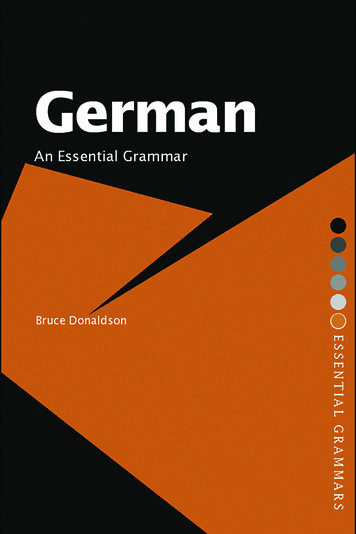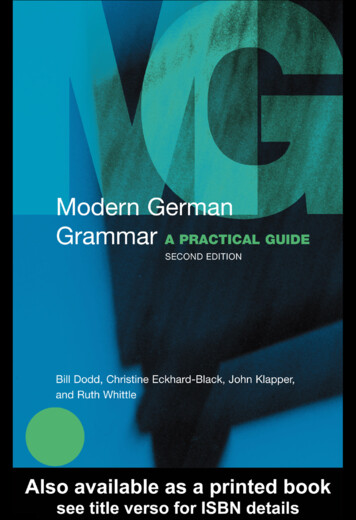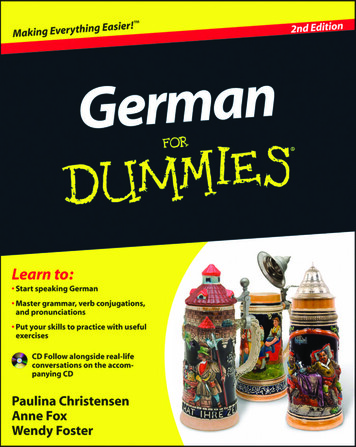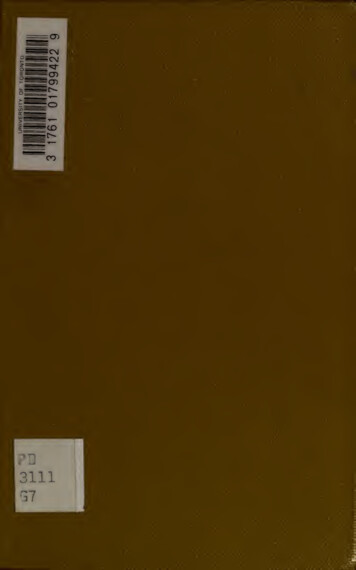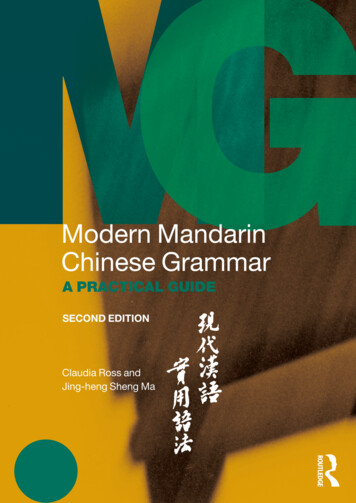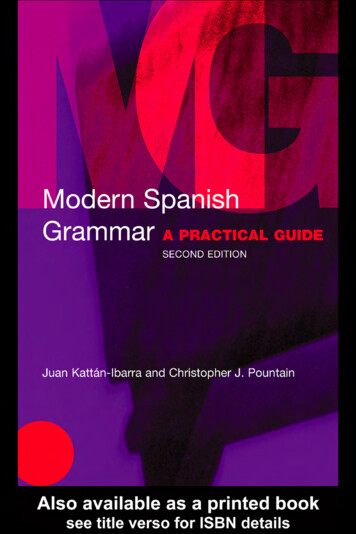
Transcription
atoxmll SEnibcrsitgtLiferatg.THE GIFT OPLONGMANS, GREEN &j l *: e :ryy:C'*rr /CO.,
Cornell University LibraryarV16193ApracticalGerman grammar.3 1924 031 282 514
ayThetineCornell UniversityLibraryoriginal oftliisbookis inCornell University Library.There are no known copyrightrestrictions inthe United States on the use of 82514
BY THE SAME AUTHORAFirstGerman Book.lation, Proverbs, Phrases, etc.AManualofTranslation,With Exercises, Piecesfor Trans-2s. dd,German Composition.With Passagesfor3 .Tales from History (Historische Erzahlungen).By Dr. Friedrich Hoffmann. Edited, with Notes.2.s.Benedix's Dr. Treuwald.Edited, with Notes, etc.RIVINGTONSWATERLOO PLACE, LONDON2s.
i
A PRACTICALGERMAN GRAMMAR
By H.AS.GermanPracticalContinuous theS''-Also sold separately,AGerman APracticalincontinuousGerman Grammar.'\s.6a.RIVINGTONSWATERLOO PLACE, LONDONProse,
A PRACTICALGERMAN GRAMMARH.S.BERESFORD-WEBBLATE Assistant master at Wellington collegeRIVINGTONSWATERLOO PLACE, LONDONti r? ?1
—"PREFACEIt would be almost as remarkable and unusual for aGerman Grammarto appear withoutan apology asfor ahouse to be built without a door, or a boat without arudder—andno wonder,already in existence, onewasfor,would imagine that the supplyfar in excess of thedemand.be remembered that in everyifjudging by the numbersBut thenart, science, oritshouldmanufacture,there is no actual advance from day to day, at leastthereever a healthy striving after a better state ofisthingsSetWhen2Kettf ofttmmer iBerkpvung.an inventor announces a " new and improvedreaping-machine or printing-press, he does so in the hopeandbelief that it contains essential qualitieswhich areabsent from those of his predecessors, and he furtherdesignsAndittomeet the increased improvementsso it is with books, be theyGuide-books, or Gazetteers.experience,whatisperceive,from our ownlacking in those already in existence,and make a humbledefect.Weof the age.Grammars, Dictionaries,effort, inpart at least, to supply the
Preface.viiiI entertain the hope thatmar may supply a fewsome portions ofTheyabsence from other works of the kind.result, partly ofmy ownspecialamong whommention of Mr. H.0. Steel,whomMaster at Winchester College, togratitude for his patiencescript,Asand formanyare theII desire tonowAssistantowe a debtofand care in revising the manu-valuable suggestions.regards the arrangement of the work,observed that thetheirexperience, partly of numeroushints from former iswillitbedivided into two parts,printed respectively in large andsmallIttype.isintended that the large type should be taken throughfirst,with the Exercises on the same (Hxx. 1-66).will give a general idea of theThisgrammar, including aminor syntax, before the minuterdetailsareenteredupon."With respect to the Declensions, the opinion ofallwhom I consulted seemed to be against the system ofWeak and Strong Declensions, and I therefore adoptedthe division according to gender, deviating aslittlefrom the favourite system ofin Otto'soffixthe nouns, asreference.Andrecommendationmoretoeasily in hiscertainly isithereitmayprivatedoes butfive declensions, asGrammar, in the hope thatthe student toititmight enablemind the gendersmore convenientnot be amiss tostudents not toforinsert,makeatoo
ixPreface.great a point of mastering the rules for the declensionsand the genders, as the numerous exceptions may onlytend to dishearten them and to weary them of thelanguage before givinga fairittrial.have written rather amply upon theImeaningof the verbal prefixes,prepositions,— theforceandand especially on theformer, becausewiU enable theitstudent to understand more thoroughly and learn morecompoundrapidly the meaning of thelatter,hardest part of the language.have endeavoured, in mostand theIn selecting examples, Icases, to choose the easiest,and to keep in view the requirementsMyverbs';because the prepositions are beyond doubt theobject is not somuchof daily intercourse.to enable the learner to readand understand Lessing and Goethe,himas to aidinI have given no fullspeaking and writing the language.vocabularies to the Exercises, as they would only swellthe size of the book ; and with Blackley and Friedlander'svery excellent German Dictionary in their hands, studentswill beamply supplied withallthe assistance they canrequire.The Examples, Exercises, and other portionsof thebookhave been gone through carefully with Herr TheodorH.Dittel,Professor ofGermanEngineering College, Cooper's Hill,opportunity of thankingtionshimatthe Eoyal Indianand Ifor his help.and amendments will be gratefullydressed tome, careamof the Publishers.glad of thisAnysugges-received, if ad-HSB -W
PREFACE TO THE NEW EDITION.InNewthispracticallyEdition of theGrammarthe rules haveremained unaltered, and there has been nochange in the numbering of the paragraphs, but theexigencies of examinations haveinmanyof the lists,admit such words asGrammarber hotterbearing the wordThe paragraphsdemanded an increasethough I must own I unwillinglyandbie SSorloanb into" practical "onaits title-page.illustrating the use of the Prepositions(§§ 296, 297, 298)have not only been supplemented, butrearranged as far as possible in a kind of alphabeticalorder,and the section on Foreign Nouns has beenwritten.Allthis, it isre-hoped, will add to the usefulnessGrammar as a book of reference. In addition tothree new Exercises on the Prepositions have beenof thethis,added, and fuller vocabularies given to the preliminaryExercises.I have to thankandmany kindfor valuable hintsfriends for their support,drawn fromtheirownH.August 18S8.experience.S.B.-W.
CONTENTS.GeBUAN HANDWBITINa,The Gbbman Language,PAOKrviixiz.The Alphabet,2—Peonunoiation(1)The Vowels4(2)The Double Vowels and Diphthongs,5(3)The Modified Vowels,6(4)Lengthened Vowels,7(5)The Consonants,(6)Pronunciation of Foreign Words,10(7)Capital Letters,10(8)Division ofWords(9)Onandf (8),ff,ft,.811into Syllables,12.PARTThe PartsI.of Speech.CHAPTER L—Pbeliminaky1,13CHAPTERn.Pbeuminaet — 2,17CHAPTERIII.20
5Declension of the Noun, §§§ 18-28.Nouns used oiJy in thePlural inCompound Plurals,English, § 36.Nounsof Measure,Doublein the Singular, § 33.German—SingularGermanAnomalous§ 37.Weight,§§ 15-17.§ 29.Singular inPlural, § 34.Plural in English, § 35.Nouns,Feminine Nouns,Compound Nouns,Nouns used onlyPlurals, §§ 30-32.§ 38.General Rules for Declension,1.Masculine Nouns, §§ 3-14.Neuter Nouns,inPlurals,Foreignetc., §§ 39, 40.§§ 41-48.CHAPTERVI.(§§ 49-59.)Declension as Pbopek NofnsNames§ 51.22(§§ 1-48.)Declension of the Noun,§ 2.of Places, §§ 49, 50.Names50The Countriesof theWorld,of Persons, §§ 52-59.CHAPTER(§§ 60-68.)'VII.Gender op Nouns,Masculine,Nouns,§ 61.§§57Feminine, § 62.64-66.Neuter,Compound§ 63.Female Appellatives,§Double67.Genders, § 68.CHAPTERTheVIII.(§§ 69-97.)ArjECTivii,66Declension, §§ 71-76.ComparisonNotes on the Adjectives,§§77-83.The Ordinal Numbers,§§ 106-of the Adjective, §§ 84-97.CHAPTERIX. (§§98-1276.)The Numeral,Cardinal Numbers, §§ 98-105.111.80Indefinite Numerals, §§ 112-127h.
Contents,CHAPTERX.(§§ 128-144.)The Adjective �132-134.§§Possessive, §§ 138-Relative and Interrogative, §§ 135-137.144.CHAPTERXI.(§§ 145-189.)The Pronouns,97Reflexive and Reciprocal, §§ 160-162.Personal, §§ 145-159.Determinative, §§ 166, 167.Demonstrative, §§ ter-177.Possessive, §§ 182, 183.rogative, §§ 178-181.Indefinite,§§ 184-189.CHAPTER Xn.The Verb,.Auxiliary§§ 194, 195 a6e«,:;The Auxiliary Verbs198.(§§ 190-273.).Sein, § 196ofMood,;.117SKJerten, §§ 197,§§ 199-201.TheSimple Regular Verb, §§ 202-204. Anomalies in the SpellingMixed Conjugations, §§ 209, 210. TheThe Irregular (Strong) Verbs,Derivative and CompoundFaictitives, § 225.of verbs, §§ 205-208.Passive Voice, §§ 211-215.§§ 216-224.Verbs, § 226,Prefixes:Double,250.§§Inseparable Verbs,ff.Simple,g 43-245;Prefixes Separable or Inseparable, §§ 247-Neuter VerbsofMotion, § 251.Reflexive Verbs,252-255.§ 230.Separable Verbs, §§ 233-239.Prefixes, § 232.§§ aacn, and Sei»,Impersonal256-260.Verbs, §§ 261-273.CHAPTERXIII.(§§ 274-286.)The Adverb,205Comparison, §§ 276-279.Place, § 282Doubt,;Adverbs of Time,of Degree, g 284etc., § 285.;§§ 280, 281;ofof Affirmation, Negation,Interrogative, § 286.
xivContents.PAGECHAPTERTheXIV.(§§ 287-298.)Preposition,With213the Genitive,the Accusative,§§ 291-295.§ 288.§ 290.With the Dative, §With the Dative andHow to translateAccusative,English Prepositions,Verbs, Adjectives, and Nouns, with Prepositions,Idioms with Prepositions,With289.§ 296.§297.§ 298.CHAPTER XV.(§§ 299-323.)The Conjunction,258Co-ordinative, g§ 300-305.Subordinative, §§ 306-318.junctiona compounded, §§ 319-322.CHAPTERAdverbial,XVI.Con-§ 323.(§ 324.)The Interjection270PARTII.Rules of Syntax.CHAPTER XVIL(§§ 325-343.)The Order of Words,PrincipalSentences,§§ s,Sentences, §§ 342, 343.CHAPTERXVIII.(§§ 344-348.)The Article,281CHAPTERXIX.(§§ 349-357.)Concord and Apposition,Concord, §§ 349-353.Apposition, §§ 354-357.286
xvContents.CHAPTER XX.Use01'(§§ 358-392.)TEE Cases289Nominative, § 358.383.Genitive, §§ 359-371.Dative, §§ 372-Accusative, §§ 384-392.CHAPTERThe SevenXXI.(§§ 393-402.)Auxiliaiiies op Mood,Saimen, § 394.3Raaett, § 395.SoSeir, § 398.SSoUttt, § 399.CHAPTER308a»uff«n, § 397.aiucfen, § 396.Saffen, § 400.XXII.(§§ 403-412.)Use oe the Tenses,316CHAPTER XXin.(§§ 413-436.)Use op the Moods,,Subjunctive, §§ 413-415 and 422.421.Imperative, §§ 423-426.(§§ 437-444.)335Pabticiplks,Present, §§ 437-438Perfect, § 441,and440.English Gerundive,APPENDIX439.A.-APPENDIXList op Onomatopoetio Woeds,Obthoobaphy.343B.APPENDIXIndex,§Attributive Construction, § 444.The PabticlbsThe New320Infinitive, §§ 427-436.CHAPTER XXIV.The.Indirect STarration, §§ 416-.353C.355357
ABBREVIATIONS.Fr.
GERMAN yi f(lye,(y (y ht/ p fraa(f/XrpofI I fther efbd-//zysylZcuiles.ica-t-Vtyccthe, he in-TviiiffVowels.(xy(y,c ,(y(y. -t ,Compourvd' stssyz& nviddla.
.German Handwriting.XVlllzm . .r ,yf %'i.-nyCm , j-« « - /ii S t-'- i- fci i i- liie//'i -i C -»-''t'*'t » t''i //C' 'ie' ,''. iMy.-//L- C'i y-t t-V/V y% 'Tt't- tyH ' 'Z . Ti - 2 % *K-- X V''
———THE GERMAN LANGUAGEThe German LanguageisGermanic family which hada branch of the great IndoitshomeinUpperAsia, andfrom which Sanscrit and other Asiatic languages, and subsequently Greek, Latin, and the Slavonic tongues are alsodescended.Later on the Germanic branchdivisions(i)splitupinto three great:Germcm.(2) Gothic.1(3)Norse (Danish, Icelandic, Swedish, and Norwegian).German again divided(i)High German.(2)Low Germaninto(Old Saxon, Anglo-Saxon, and Frisian).There were three chief periodsofHigh German,calledrespectively(i)Old High German (7th-llth century).(2)Middle High German (12th-14th century).(3)New High German(from the time of Luther,d.1546,to the present day). Valuable to the student of philology on account of a translation ofby TJlfilas, a Gothic Christian bishop (360-380), the oldestthe Bibleworkina Germanicdialect.
The German Language,Old High German was chiefly distinguisiiedinflexions.Itbyitsmanyhad a Dual number, an Instrumentalcase,and twenty-five Substantive endings.Of Middle High German the principal dialect was theSwabian, the language of the court and of the Minnesanger.Itwks distinguished mainly by the diminution ofand consequently a corresponding increase tions,connectingAtthisperiod, too, the so-called anjletf Jradbe, or official style,wasdeveloped, and formed the basis of the popular language.It ismainly to Luther and his writings that the Germansare indebted for purifying the languagethe form in whichOnitthe whole,simpler and perhapsnessand powerlanguage.nowand establishingit inexists.however,thoughModem Germanmore rhythmical, yetof expressionitislacks the rich-which characterise the ancient
GERMAN GRAMMAR
The Alphabet.Gekmas Lbptbrs.Name(according to English pronunciation).21aah33bbayectsaySbdayec8f sayseffgayhah3i3jeeyottkahk12tellm2»memm31nennD
Pronunciation.Pronunciation.1.31,The Vowels.a long: like a.m father, as laitn, Cxnal, Soger.short: has a similar sound, but must be inore slurred:overalt,:'i)at,Beware of pronouncingStatu.itasin the English hat.Q,tlong3,tlonglong„:e„let,as:„bit,aslike o insoZe,as„::shortiSle' , jebeS, SEUe' l.6effer, retten, Je .:like ee in sheep, as:shortO,like ai in rail, as:short:wibcr, Siter, bit.SDo' Ie, Sflot' , ober.:rather longer than the o in:rhyme with the Englishfrost,comes between the two, asU,Itlong:likeshort:'§),9 occurs„—Finalu in« „nowlike 3,Note. i .581 , ritten,:erule, asfull,::Srofl does notcost.nor withboasi,but9locE, oft, fofl.S u' rc, SDJutl, t )ut.as: unb, muf, Sdud.only in foreign words andispronouncedt.must always be sounded,as: ibe,hit, Slamt.
The Double Vowels and Diphthongs.2.The Double Vowels and Diphthongs;aa like longa,as:- aar, aal.ee„„e,„-§ecr, ecle.00„„D,„WlaoS, SBoot.at,,»more prominencein pike withto the a sound, as:jQaiit, Wlai.au„ow in Jww with more prominence to theasound, as: §aut (pr. almost ha-out), d auin, faul.in pike, aset„ieu,,o«/in boy, butaste„Sflcife, .Seil,:ee in:more nearly approaching the(between Aoy and §eus/iee j,bein.as:2)Jiene, tiiel.ihie), neu, (ulen.in pie,
Pronunciation.The Modified Vowels.3.Just as in English we form a few plurals of nouns and pastby changing the vowel of the root {e.g. man,tenses of verbsmen; draw,drew),terminationsand in Latin by changing tha
ByH.S.BERESFORD-WEBB APracticalGermanGrammar,withExercisesin ContinuousProse. S''-Alsosoldseparately, APracticalGermanGrammar,without the Exercises.4J .
